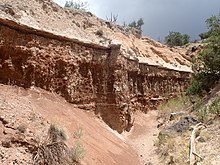Rock Point Formation
The Rock Point Formation is a geologic formation in New Mexico and Utah. It preserves fossils dating back to the late Triassic.
| Rock Point Formation Stratigraphic range: late Triassic | |
|---|---|
 Rock Point Formation capped by Entrada Formation, near Youngsville, New Mexico | |
| Type | Formation |
| Unit of | Chinle Group |
| Underlies | Wingate Sandstone |
| Overlies | Petrified Forest Formation |
| Thickness | 70 m |
| Lithology | |
| Primary | Siltstone |
| Other | Fine sandstone |
| Location | |
| Coordinates | 36.5247221°N 109.5560845°W |
| Region | Utah, New Mexico |
| Country | United States |
| Type section | |
| Named for | Rock Point School, Apache County, Arizona |
| Named by | Harshbarger, J.W., Repenning, C.A., and Irwin, J.H., 1957 |
History of investigation
The unit was first named by Harshbarger, Repenning, and Irwin in 1957, who assigned Gregory's (1917) "A" division of the Chinle Formation to the Wingate Formation as the Rock Point Member. It was named for Rock Point School, located near the type exposures at Little Round Rock.[1] Stewart et al. argued in 1972 that the unit has more affinity with the Chinle,[2] and Dubiel assigned the Rock Point to the Chinle in 1989.[3] The unit has created an unusual amount of controversy, but Lucas et al. raised it to formation rank within the Chinle Group in 2005.[4]
Description

The formation is up to 70 m thick and is mostly reddish-brown and grayish-red massive siltstone and fine sandstone beds. It is the uppermost portion of the Chinle Group wherever it is exposed. In the Chama basin, its base is placed at the first persistent sandstone bed above the mudstones of the Petrified Forest Formation. Its contact with the overlying Entrada Sandstone is sharp.[4]
Fossils

The famous Whitaker quarry of Ghost Ranch, New Mexico is believed to belong to the Rock Point Formation, although these beds have also controversially been assigned to the Owl Rock Formation.[4] This quarry has also been referred to as the Coelophysis quarry due to preserving a large number of specimens of the early theropod dinosaur Coelophysis bauri.[5]
Footnotes
- Harshbarger et al. 1957
- Stewart et al. 1972
- Dubiel 1989
- Lucas et al. 2005, p.176
- Rinehart et al. 2009
References
- Dubiel, R.F. (1989). "Sedimentology and revised nomenclature of the Upper Triassic Chinle Formation and the Lower Jurassic Wingate Sandstone, northwestern New Mexico and northeastern Arizona" (PDF). New Mexico Geological Society Field Conference Series. 40: 213–223. Retrieved 25 May 2020.
- Harshbarger, J.W.; Repenning, C.A.; Irwin, J.H. (1957). "Stratigraphy of the uppermost Triassic and the Jurassic rocks of the Navajo country". U.S. Geological Survey Professional Paper. 291. Retrieved 25 May 2020.
- Lucas, Spencer G.; Zeigler, Kate E.; Heckert, Andrew B.; Hunt, Adrian P. (2005). "Review of Upper Triassic stratigraphy and biostratigraphy in the Chama Basin, northern New Mexico" (PDF). New Mexico Geological Society Field Conference Series. 56: 170–181. Retrieved 29 April 2020.
- Rinehart, L.F.; Lucas, S.G.; Heckert, A.B.; Spielmann, J.A. & Celesky, M.D. (2009). "The paleobiology of Coelophysis bauri (Cope) from the Upper Triassic (Apachean) Whitaker quarry, New Mexico, with detailed analysis of a single quarry block". New Mexico Museum of Natural History & Science, A Division of the Department of Cultural Affairs Bulletin. 45: 260.CS1 maint: uses authors parameter (link)
- Stewart, J.H., Poole, F.G., and Wilson, R.F., 1972, Stratigraphy and origin of the Chinle Formation and related Upper Triassic strata in the Colorado Plateau region, with sections on sedimentary petrology by R.A. Cadigan and conglomerate studies by William Thordarson and H.F. Albee: U.S. Geological Survey Professional Paper, 690, 336 p.